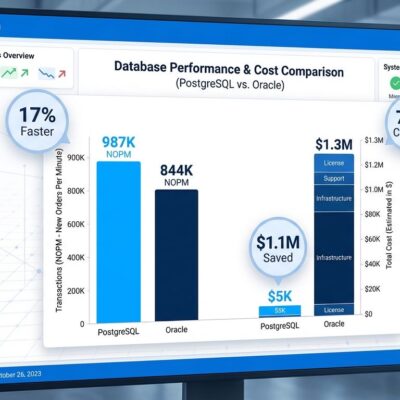
Cloud spending hit $679-723 billion in 2025, yet organizations waste 30-32% of that spend ($200-230B annually) on idle resources, orphaned infrastructure, and inefficient pricing models. Despite waste reduction being the #1 priority across all organization sizes according to the FinOps Foundation, the problem shows minimal improvement: 35% in 2023 dropped only to 32% in 2025. The paradox is brutal. Everyone knows the problem. Everyone claims it’s a priority. Yet hundreds of billions continue burning. The root cause isn’t technical complexity or lack of tools—it’s organizational dysfunction at scale.
The $44.5B Organizational Disconnect
Harness’ “FinOps in Focus 2025” report quantifies the damage: $44.5 billion wasted on underutilized infrastructure alone, representing 21% of enterprise cloud spend. The culprit? FinOps teams and developers operating in silos. Moreover, 52% of engineering leaders cite this organizational disconnect as the primary driver of wasted spend.
The visibility gap is even worse. Only 43% of organizations have real-time data on idle resources. Furthermore, just 39% track orphaned resources. Consequently, a mere 33% monitor over or under-provisioned workloads. FinOps teams generate cost reports that sit ignored. Additionally, developers lack authority to act on recommendations. Finance and engineering don’t communicate. Therefore, the result is clear: teams know waste exists but can’t fix it because no one has both visibility AND authority to act.
HashiCorp’s State of Cloud Strategy Survey reinforces the dysfunction: 91% of enterprises admit wasting money in the cloud, yet only 8% qualify as “highly cloud mature.” This maturity gap explains why waste persists despite awareness. In fact, most organizations lack the processes, tooling, and culture to effectively manage cloud spend.
Where the $200B Goes: Cloud Waste Breakdown
Cloud waste isn’t a single problem—it’s a constellation of organizational and technical failures. Industry consensus from BCG, Flexera, and ParkMyCloud places total waste at 30-40% of spend, broken down as: idle compute instances (15-25%), orphaned resources like unattached volumes (10-15%), overprovisioned capacity (20-30%), inefficient pricing models versus reserved instances (10-20%), and storage bloat from old logs and temp files (5-10%).
AI and machine learning workloads compound the problem, driving 40% of unexpected bills. Cloud providers face supply constraints—Microsoft can’t build infrastructure fast enough to meet demand—pushing costs per unit higher. Meanwhile, developers spin up test environments and forget to shut them down. As a result, resources get orphaned when instances terminate. Teams overprovision “to be safe” but never right-size afterward.
The developer impact is measurable. Flexera’s 2025 survey shows 82% of enterprises report higher-than-expected cloud bills. Additionally, 37% now list cloud costs as a top-three budget concern. This isn’t just CFO hand-wringing—it affects hiring budgets, tooling decisions, and project timelines. Developers waste time fighting cost overruns instead of building features.
Why Cloud Optimization Tools Won’t Save You
Organizations invest heavily in FinOps platforms, cost monitoring dashboards, and automated rightsizing tools. Nevertheless, waste improvement remains minimal. The FinOps Foundation survey confirms cloud waste reduction is the number one priority across all organization sizes, but the numbers tell a different story: 35% to 32% over two years is barely movement.
Tools can identify cloud waste but can’t force organizational action. A cost dashboard showing idle instances doesn’t help if no one has time or authority to shut them down. However, automated recommendations sit ignored when engineering prioritizes velocity over efficiency and finance lacks technical context to challenge decisions. One firm discovered 35% of project management SaaS licenses hadn’t been accessed in 90+ days, saving nearly $200,000 by canceling them—but only after a manual audit forced the issue.
Reddit’s cloud cost horror stories illustrate the organizational chaos: autoscaling misconfigured to create hundreds of instances overnight, rogue Lambda functions running millions of invocations, forgotten BigQuery jobs burning budget for months after projects end. These aren’t technical failures—they’re cultural ones. No one owns lifecycle management. Furthermore, no one enforces cleanup. No one is accountable for the waste.
This challenges the industry narrative that better tools equal solved problems. Buying a FinOps platform without organizational commitment to act on findings is just wasting money on waste detection. Therefore, the real solution requires unglamorous work: cross-functional collaboration, clear ownership, automated lifecycle policies, and cultural discipline around resource hygiene.
What Actually Works: Cross-Functional Accountability
Organizations that succeed at cloud cost optimization don’t just buy tools—they change culture. The successful pattern from case studies: dedicated FinOps team (even 1-2 full-time employees initially), C-level sponsorship for cultural change, cross-functional collaboration with engineering-finance-product alignment, 100% tagging enforcement (owner, environment, cost center, expiry date), automated lifecycle management where resources self-destruct unless extended, and real-time visibility accessible to all teams.
The results prove the approach works. Typical FinOps implementations achieve 20-40% cost savings with ROI positive in 3-6 months and ongoing annual savings of 25-35%. Moreover, storage-specific wins are even more dramatic—automated cleanup of old logs and temporary files can reduce costs by 50-80% for older data.
The FinOps Foundation’s framework codifies what works: cross-functional collaboration instead of silos, ownership pushed to the edge so engineers are accountable for costs, real-time visibility rather than monthly post-mortems, and centralized enablement with FinOps teams providing tools and training. Implementation follows a proven path: establish visibility first (months 1-3 with tagging and cost allocation), prove ROI with quick wins (months 4-6 cleaning up orphaned resources and scheduling dev/test environments), then scale with automation (months 7-12), and maintain continuous optimization ongoing.
The message is clear: this is solvable, but it requires organizational commitment beyond tool purchases. The alternative is watching another $200 billion burn in 2026.
Key Takeaways
- Cloud waste burns $200-230 billion annually (30-32% of $679-723B total cloud spending) despite being the number one stated priority across organizations
- $44.5 billion wasted on underutilized infrastructure due to FinOps-developer organizational disconnect, with 52% citing team silos as the primary driver
- 91% of enterprises admit wasting money, yet only 8% qualify as highly cloud mature—this maturity gap explains why waste persists despite widespread awareness
- Tools are necessary but insufficient without organizational change: cross-functional accountability, cultural discipline, and automated lifecycle policies are required
- Proper FinOps implementation delivers 20-40% savings with ROI positive in 3-6 months, but requires C-level support and dedicated team ownership











